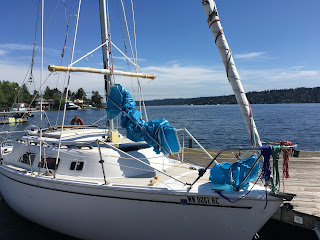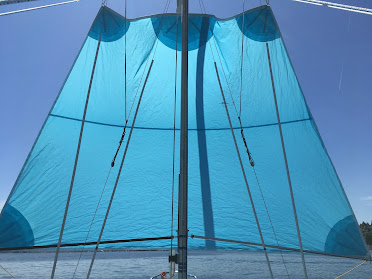Maiden voyage...
The day has arrived. It’s time to see if this wacky idea will actually work out on the water. I specifically chose a light wind day for the first sea trial and a friend from RSC was available to come along and help out. After yesterday’s dry run at the dock, I modified the rigging procedure; today, I followed the revised procedure and double checked that all lines ran where they wouldn’t snag or grab anything when the sail was hoisted.
Here is a picture of the port side clew. You can see the attachment of the foreguy, crossjack and sheet.
Thankfully, my first mate is a competent and experienced sailor, so it didn’t take much of a crew briefing to explain the very unconventional rigging setup and the plan for the day’s short cruise. We shoved off and motored upwind for a bit, then turned downwind and hoisted the sail. The crossjacks can snag on the forward lifelines but that can be managed by keeping the foreguys tight until the yard-spar is halfway up the mast.
When I designed the sail and calculated the dimensions of the head and foot, I had to make an assumption about the draft of the sail along the top and bottom edge. The yard-spar is 84 inches long, so I figured 10% of that (8 inches) would be a good guesstimate for the draft along the top edge; I then came up with 100 inches as the dimension of the sail’s head (top edge) by using the equation that describes the circumference of an ellipse. As you can see, I should have assumed a smaller draft (5 inches is probably better) since the top edge of the sail does not have a very nice shape in light winds. In heavier winds, it might fill out more, but I will try installing some beefy eye bolts in the end of the yard-spar. When I attach the outer head snap shackles to these eye bolts, it will move each top corner of the sail out another three inches or so; this will reduce the draft and should give the sail a nicer profile.
After playing around with the position of the braces, sheets, crossjacks and foreguys on different wind angles, we successfully got the sail lowered and stowed. Again, the key is to tighten the foreguys and swing the crossjacks as far forward as possible to keep them from snagging on the forward lifelines. Now I wanted to see if I could convert the boat from square-rigged to fore-and-aft rigged while underway. After stowing all the lines and securing the square sail to the crossjacks, I went forward, retrieved the jib sheets, routing them around the shrouds and replaced the square sail sheets with the jib sheets in the jib car and winch. We unfurled the foresail and we’re able to tack (again, in very light winds) without the sheets or sail snagging on the yard-spar.
Just for good measure, we furled the genoa and raised the square sail again. It wasn’t a fluke; it really does work! Overall, it was a very successful maiden voyage. Everything worked as expected, nobody got hurt and the boat didn’t sink. After I modify the yard-spar, the next step is to see how she handles heavier wind.
Thanks for reading!
Link to design document describing sizing the yard-spar and square sail dimensions:



